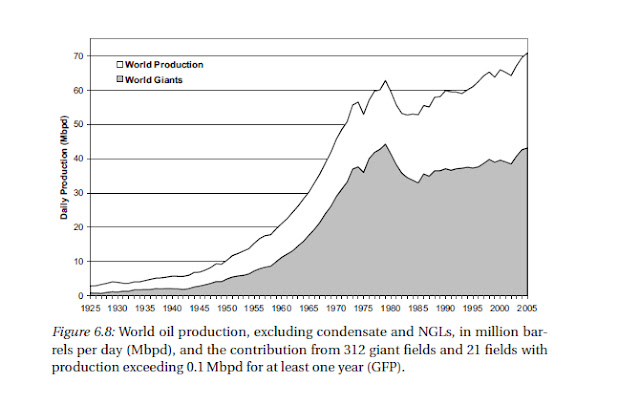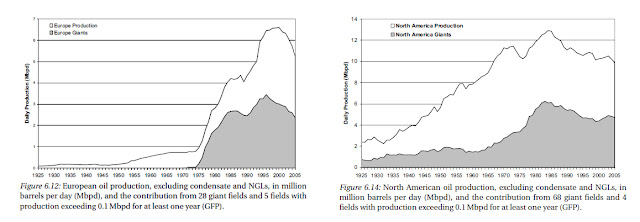So far, in the Peak Oil Series, we first looked at peak oil theory, and some principles of oil reserves. We also considered sources of new reserves-- forecasts for new discoveries, lag in recognizing reserves in new fields, and growth in recovery efficiency. This post is about another source of new oil-- discovered, undeveloped reserves in the Middle East.
Let’s take a look at two charts, that taken together have significant implications for peak oil.
The first chart is by Fredrik Robelius, from his PhD thesis at the University of Uppsala, 2007. The chart shows the rate of production in the Middle East, from giant fields and from smaller fields
The second chart is the “creaming curve” for the Middle East, by Jean Laherrere, 2010. Cumulative reserves discovered is on the vertical axis, and fields are on the horizontal axis in the order of discovery. Note that the curve initially rises sharply and then flattens; the largest fields are found first, and progressively smaller fields are discovered with increasing exploration maturity.
Let’s see why these charts are significant.
Robelius presents an analysis of giant fields as an approach to peak oil. Giant fields are defined as fields with greater than 500 million barrels of ultimate recoverable reserves. Historically, giant fields have dominated production.
Production plots for Europe and North America show mature production in clear decline. Production from fields smaller than giant fields represent about half of peak and post-peak production.
Production plots for Africa and Asia are show currently increasing production. Production in Africa is increasing, due to contributions from deepwater offshore fields, while Asian production is increasing on increasing contributions from smaller fields.
Charts for Eurasia (Former Soviet Union) and South America show peaks, decline, and resurgent production. In both cases, the early peak and decline represent easily-accessed oil, and the later peak represents more remote and difficult production. Political events contributed to the decline in both cases. The contribution of smaller fields remains significant, again representing about half of current production.
Robelius’ plot for the Middle East shows a dramatically different picture. First, note that the scale of the chart is considerably larger than any of the other continental charts, with current production exceeding 20 million bpd. Second, note that about 90% of production is coming from 79 giant fields. Production from giant fields is still increasing, and smaller fields have made relatively little contribution to date.
Recall that oilfields have a fractal-like size distribution. Large fields imply the existence of smaller fields. From this chart, and comparison to the charts of mature petroleum provinces, we can conclude that substantial additional production can be expected from fields smaller than 500 million barrels in the Middle East. If smaller fields match the contribution of giant fields, as has happened in every other petroleum province, we can expect an additional 20 million barrels per day of production from smaller fields in the Middle East.
From Robelius’ charts alone, it might be suggested that the super-giant fields (> 10 billion barrels) of the Middle-East dwarf the contribution of small fields, and that small fields in the Middle-East will not reach the percentage contribution seen in other parts of the world. That is probably partly true. But we have another piece of data in the creaming curve presented by Jean Laherrere.
In Laherrere’s chart, we see that 1400 fields have been discovered in the Middle East. The upper bright green curve represents official reserve estimates, totaling 1000 billion barrels. Laherrere has discounted the official reserves by 30% to create the dark green curve, totaling 700 billion barrels. (Laherrere cites sources describing 300 billion barrels of the official figure as speculative reserves.)
Consider the lower curve, and estimate the reserves attributable to 79 fields. (Remember that the fields are not in rank order, but in order of discovery.) The sum of the steepest parts of the curve, for 79 fields, would seem to be about 400 billion barrels. This still leaves about 300 billion barrels of discovered reserves in over 1300 oilfields which have barely been tapped.
Development of smaller fields in the Middle East will require substantial capital, and political stability. But when the giant fields of the Middle East begin their inexorable decline, there is a substantial resource available in smaller fields which can be brought on production. Depending on the timing of development, these fields may raise the volume of global peak production, to the range of 90 – 100 million barrels per day, or delay the peak by some years.
-------------------------
-------------------------
Jean Laherrere is co-author of “The End of Cheap Oil”, Scientific American, 1998.
Other publications can be found on the APSO (Association for the Study of Peak Oil) France website.
Fredrik Robelius, Giant Oil Fields – The Highway to Oil
http://uu.diva-portal.org/smash/record.jsf?pid=diva2:169774







I Finally Got Helped !! I'm so excited right now, I just have to share my testimony on this Forum.. The feeling of being loved takes away so much burden from our shoulders. I had all this but I made a big mistake when I cheated on my wife with another woman and my wife left me for over 4 months after she found out.. I was lonely, sad and devastated. Luckily I was directed to a very powerful spell caster Dr Emu who helped me cast a spell of reconciliation on our Relationship and he brought back my wife and now she loves me far more than ever.. I'm so happy with life now. Thank you so much Dr Emu, kindly Contact Dr Emu Today and get any kind of help you want.. Via Email emutemple@gmail.com or Call/WhatsApp cell number +2347012841542
ReplyDelete